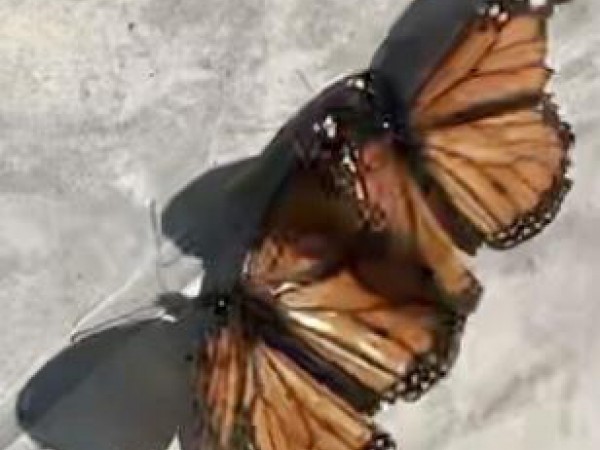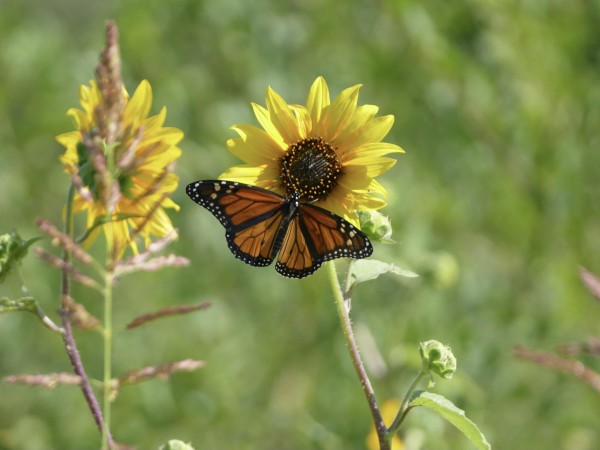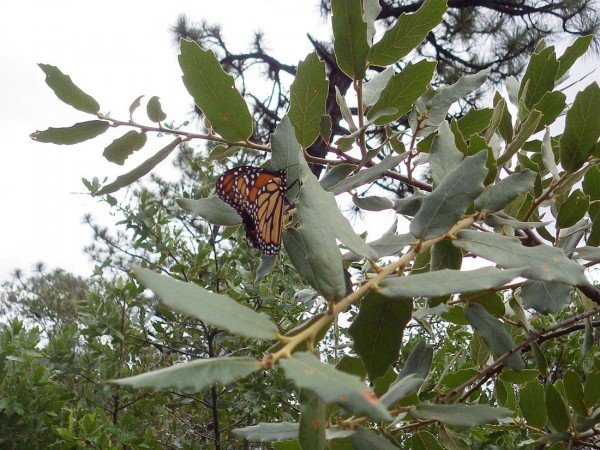Letter from Gail Morris: Western Monarch Fall 2021 Report #2
Published: 09/15/2021
Note: Observations highlighted in this report are from August 30–September 6. To explore more recent observations, check out "The Leading Edge" section of the news update and explore our maps.
Dear Western Monarch Friends,
Monarchs that are freshly eclosing now will become part of the migrating generation, especially in the Northwest. Flowers are now the main passion of these monarchs as they nectar to gain lipids to sustain their long and arduous flight. Milkweed in bloom will still be a favorite nectar source but the new fall blooming nectar resources will soon grab their attention. Migrating monarchs are not breeding so they live through the winter months. Some breeders will still be embedded in their numbers but they will live out their shorter 3 to 6 week lifespan giving rise to the migration generation.
Reports arriving from throughout the West are of more monarchs than last year at this time but we won’t know the full numbers until the counts are conducted in November. Look for fresh pockets of fall blooming annuals and perennials as monarchs move across the West.
Monarch Sightings
Patricia in Oxnard found 7 monarchs on August 30. “They were high in the trees getting the last bit of sunshine. The fog was coming in.”
Meanwhile Maize in Carlsbad, California, reported 8 monarchs on August 30. “Observed approx eight (8) different adult Monarchs of which these two ended up mating on the ground and then flying away attached while still mating in the air landing on palm tree fronds, in residential backyard.”
Annete visited American Fork, Utah on September 3. “We saw 13 Monarchs in Native habitat today. Three lifted off of Joe Pye flowers at the same time. 20 minutes later Flint was taking this picture of a Monarch on Joe Pye while another was circling my head within reaching distance. The excursion ended with a Monarch came at to greet us at the cotton wood tree as we were leaving.”
Rebecca in Belen, New Mexico, reported 8 monarchs September 3. “These were on the grounds of the Whitfield Wildlife Conservation Area in Belen, NM. There are many sunflowers there and Horsetail Milkweed.”
Della in San Simon, Arizona on September 5 reported one monarch. “My friends Christi and Hector spotted this adult Monarch hanging out in an oak tree on Sunday September the 5th. It appears to be resting and in good condition. It was between 9am and 12 noon. They were hiking just north of Cave Creek Ranch, near Portal in the Chirichuas. Temps mild in the mid 80s and over cast. Possibly a male?”
Judy in Mckinleysville, California, saw one monarch on September 6. “A brief visit today from the only monarch I have seen this year.”
Monarch Look-alikes
This week several reports in the lower deserts were photos of queen butterflies rather than monarchs. This is easy an easy (and common) mistake to make as they look similar. Take a few moments to learn the difference. There are several ways to tell, but perhaps the easiest way to distinguish them is the location of the white dots in their wings. In monarchs, the white dots are only in the black areas. If you see white dots in the orange, you have a queen butterfly. Monarchs and queens are in the same genus (danaus), and they share milkweed as a host plant. Here is a set of photos to tell the difference.
A few people also thought a viceroy butterfly was a monarch. Again, they do look similar but here is a link to learn how to tell the difference.
Get Ready!
Be sure to have fall blooming nectar available to feed monarchs on their long journey to the overwintering sites. Look now for key plots of migration nectar maturing to bloom and be ready to enjoy this spectacular event. Keep your camera or phone handy and take photos to report to Journey North.
Report your sightings!
Always report your monarch sightings in every life stage. Keep a camera in hand to document your findings and include as much information as possible such as what the monarch was doing, feeding on or any noteworthy find. Thank you for your support. Your contribution of data increases the understanding about monarchs.
Gail Morris is the Coordinator of the Southwest Monarch Study (www.swmonarchs.org), a Monarch Watch Conservation Specialist, and the Vice President of the Monarch Butterfly Fund and the Central Arizona Butterfly Association. The Western Monarch Population News is based on comments provided to Gail Morris. We hope to increase the number of sightings and therefore photos and comments entered into the Journey North. We rely on the volunteers who communicate regularly with Gail and who agree to participate in our effort to increase awareness of the population of western Monarchs. You can reach her at gail@swmonarchs.org.






